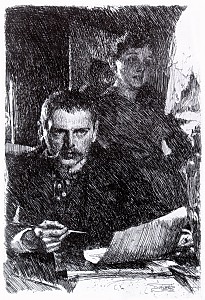
Anders
Zorn
1860-1920 |
The Self-Portraits of
Anders Zorn
The great Swedish master looks into the mirror.
 nders Zorn (1860-1920) occupies an enviable
place in art history. His name is invariably
included in an illustrious quartet of late nineteenth-century/early
twentieth century masters of the art of premier
coup (direct stroke) oil technique. The four
names which are customarily linked are: John
Singer Sargent (American), Joaquin Sorolla (Spanish),
Giovanni Boldini (Italian) and Zorn (Scandinavian).
Legion were (and are) the painters who have
attempted this very difficult and demanding
technique, but these four, working contemporaneously,
were the standard-bearers of the discipline
in their era.
nders Zorn (1860-1920) occupies an enviable
place in art history. His name is invariably
included in an illustrious quartet of late nineteenth-century/early
twentieth century masters of the art of premier
coup (direct stroke) oil technique. The four
names which are customarily linked are: John
Singer Sargent (American), Joaquin Sorolla (Spanish),
Giovanni Boldini (Italian) and Zorn (Scandinavian).
Legion were (and are) the painters who have
attempted this very difficult and demanding
technique, but these four, working contemporaneously,
were the standard-bearers of the discipline
in their era.
Zorn's work is always exciting. His draftsmanship
is superb. His brushwork is fresh, direct and
animated. His compositions are frequently unconventional.
For the working artist who needs inspiration
to free his hand from hesitation and restraint,
Zorn is the perfect artist to study. Here are
four examples of his brilliant work, all self-portraits:
 |
1. Self-Portrait With Model
Zorn's
best-known self-portrait depicts
the artist revealed by a very strong
side light which divides the face
into light and dark. The artist
wears a light gray smock, high white
collar, and full artist's cravat.
The palette shows the three pigments
which form the basis of his flesh
tones: white, yellow ochre and cadmium
red light (or vermilion).
In
a highly unconventional arrangement,
a large dark void occupies the center
of the composition, with the resting
model (who covers herself with a
dark wrap) in the upper right corner.
Note the refection of the model's
feet in the polished floor.
Oil
on canvas, 46 x 37 inches
(117cm x 94cm)
National Museum of Sweden
|
| page 1
2 3
4 |
|
|